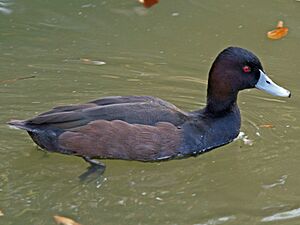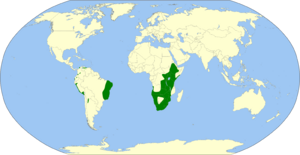Southern pochard facts for kids
Quick facts for kids Southern pochard |
|
|---|---|
 |
|
| Male southern pochard | |
 |
|
| Female southern pochard | |
| Conservation status | |
| Scientific classification | |
| Genus: |
Netta
|
| Species: |
erythrophthalma
|
 |
|
| Synonyms | |
|
|
The southern pochard (Netta erythrophthalma) is a type of duck. It belongs to a group of ducks called Netta. There are two main kinds of southern pochards. One lives in South America and is called N. e. erythrophthalma. The other lives in Africa and is known as N. e. brunnea.
The South American southern pochard lives in many different places. You can find it in countries like Colombia, Venezuela, Brazil, and Argentina. These ducks like shallow fresh water with plants growing under the surface. They can live from lowlands up to high mountains, about 3,700 meters above sea level.
The African southern pochard lives from the Cape region up to the Ethiopian highlands. They live on water bodies, whether they have plants growing out of the water or not. In the past, these ducks traveled a lot. But now, with more farm dams built, they tend to stay in one place. You can find many of them in Africa's central plateaus. They also live in the southwestern areas that get winter rain.
Contents
Southern Pochard Habits and Life
Southern pochards are very friendly and like to be with other ducks. They have been seen in huge groups, sometimes with as many as 5,000 ducks together!
Nesting and Reproduction
When it's time to build a nest, southern pochards like to be alone. They build their nests from leaves and stems. These nests are usually found on river banks, hidden by lots of vegetation.
The female southern pochard lays a group of eggs, called a clutch. She usually lays between six and fifteen eggs. The mother duck then sits on the eggs to keep them warm. This is called incubating, and it takes about 20 to 28 days. Once the baby ducks hatch, their mother quickly leads them to the water.
What Southern Pochards Eat
Southern pochards mainly eat aquatic plants. They find these plants by diving underwater. Adult ducks also eat small water creatures. This includes larvae and pupae, which are young forms of insects. They also eat other parts of plants.
Conservation Status
The number of southern pochards has been going down since the 1970s. In 2016, there were about 25,000 southern pochards in South America. However, this number might be too high because there wasn't enough information. It's important to keep track of these ducks to help protect them.
Images for kids



